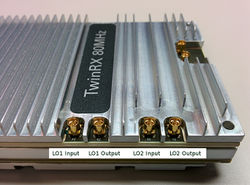Difference between revisions of "TwinRX"
(→RF Specifications) |
(→RF Specifications) |
||
| Line 121: | Line 121: | ||
* 10MHz - 6GHz | * 10MHz - 6GHz | ||
| − | <span style="background:#FF0000">''' | + | <span style="background:#FF0000">'''Finalized Numbers Needed'''</span> |
| + | |||
'''Noise Figure''' | '''Noise Figure''' | ||
{| class="wikitable" style="width:60%" | {| class="wikitable" style="width:60%" | ||
Revision as of 13:52, 8 August 2016
Contents
- 1 Device Overview
- 2 Key Features
- 3 Daughterboard Specifications
- 4 RF Specifications
- 5 Hardware Specifications
- 6 Environmental Specifications
- 7 USRP Compatibility
- 8 Schematics
- 9 Mechanical Information
- 10 RF Connectors
- 11 Local Oscillator Connectors
- 12 Certifications
- 13 Certificate of Volatility
- 14 RF Performance Data
- 15 Downloads
Device Overview
The TwinRX daughterboard for the USRP X Series SDR platform is a two-channel superheterodyne receiver designed for high performance spectrum monitoring and direction finding applications. The receiver is tunable from 10 MHz - 6 GHz and has 80 MHz of instantaneous bandwidth per channel, providing the versatility nessary to analyze a variety of signals in multiple bands of interest. Each channel has an independent RF signal chain with preampilifiers, preselectors, and two mixer stages for superior selectivity. Users can tune the two channels independently to simultaneously montior uplink and downlink communication with a combined bandwidth of 160 MHz. The ability to share the LO between channels across multiple daughterboards enables the phase-aligned operation required to implement scalable multi-channel phased-arrays. The receiver is capable of fast frequency hopping to detect frequency agile emitters. Configurable RF attenuation and preamplication allow users to optimize dynamic range in favor of noise figure for faint signals, or IP3 for stronger signals. UHD automatically configures the RF signal path for optimized performance in the pre-defined use cases, and provides the flexibility to adjust settings manually. Support for RFNoC on the X Series motherboard enables deterministic FPGA-accelerated computations for real-time spectrum analysis.
Key Features
|
Daughterboard Specifications
Features
- 2 superheterodyne frontends (2 receive)
- 80 MHz per channel
- Independent tuning
- LO Sharing Capability
- Coherent and phase-aligned operation
- Preselection Filters
- RF Shielding
Antennas
Receive: RX1 or RX2
Gains
- Receive Gains Range: 0-95dB
Bandwidths
- TwinRX: 80 MHz per channel ( 160 MHz total )
Sensors
- lo_locked: boolean for LO lock state
Ports
The TwinRX has six MMCX RF connectors on it.
| Connector | Description | Damage Threshold/Max Output |
|---|---|---|
| J1 | LO2 Export | 0 dBm output |
| J2 | LO2 Input | +20dBm input |
| J3 | LO1 Export | +5 dBm output |
| J4 | LO1 Input | +10dBm input |
| J5 | Antenna 1 connector (RX1) | +10 dBm input |
| J6 | Antenna 2 connector (RX2) | +10 dBm input |
Preselector Filters
| Band | Range |
|---|---|
| LB1 | 10 - 500 MHz |
| LB2 | 500 - 800 MHz |
| LB3 | 800 - 1.2 GHz |
| LB4 | 1.2 - 1.8 GHz |
| HB1 | 1.8 - 3.0 GHz |
| HB2 | 3.0 - 4.1 GHz |
| HB3 | 4.1 - 5.1 GHz |
| HB4 | 5.1 - 6.0 GHz |
- Each preselector filter has a ±40 MHz band overlap.
RF Specifications
Freq Range
- 10MHz - 6GHz
Finalized Numbers Needed
Noise Figure
| Frequency | Preamp Enabled | Preamp Disabled |
|---|---|---|
| 10 MHz - 3 GHz | < 5 | < 29 |
| 3 GHz - 5 GHz | < 4 | < 24 |
| 5 GHz - 6 GHz | < 8 | < 32 |
RX Third Order Intercept (dBm)
| Frequency | Full Scale = -45 dBm | Full Scale = -30 dBm | Full Scale = -20 dBm |
|---|---|---|---|
| 10 MHz - 1.8 GHz | -8 | -2 | 16 |
| 1.8 GHz - 3 GHz | -10 | -1 | 14 |
| 3 GHz - 6 GHz | -13 | -1 | 12 |
Phase Noise (dBc/Hz)
| Frequency Offset | 0.9 GHz | 2.4 GHz | 5.8 GHz |
|---|---|---|---|
| 10 kHz | -88 | -86 | -82 |
| 100 kHz | -105 | -107 | -103 |
| 1 MHz | -124 | -127 | -127 |
Hardware Specifications
- Ettus Research recommends to always use the latest stable version of UHD. Minimum UHD version is 3.10.0.0
TwinRX
- Current Hardware Revision: 2
- Minimum version of UHD required: 3.10.0.0
- Minimum version of GNU Radio required: 3.7.10
Environmental Specifications
Operating Temperature Range
- 0-40 °C
Operating Humidity Range
- 10% to 90% non-condensing
USRP Compatibility
- X Series only
Schematics
TwinRX Schematics *Needed
Mechanical Information
Drawings
- PDF Format *Needed
RF Connectors
|
The antenna ports are MMCX connectors with 50 ohm input impedance. By default Antenna 1 (RX1) is routed to Channel 1 and Antenna 2 (RX2) to Channel 2. This routing can be changed to swap the antennas or to share a single antenna to both channels. The damage threshold for the antenna inputs is 10 dBm. In practice the available gain makes much lower input powers recommended for achieving the best dynamic range and noise figure. |
Local Oscillator Connectors
|
Certifications
RoHS
As of December 1st, 2010 all Ettus Research products are RoHS compliant unless otherwise noted. More information can be found at http://ettus.com/legal/rohs-information
Certificate of Volatility
- Media:volatility TwinRX r1 1.pdf *Needed
RF Performance Data
- TwinRX without UHD Corrections *Needed


